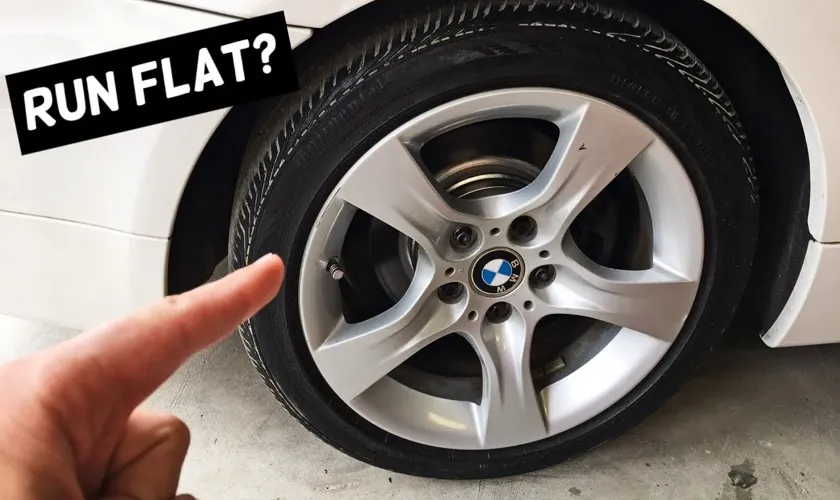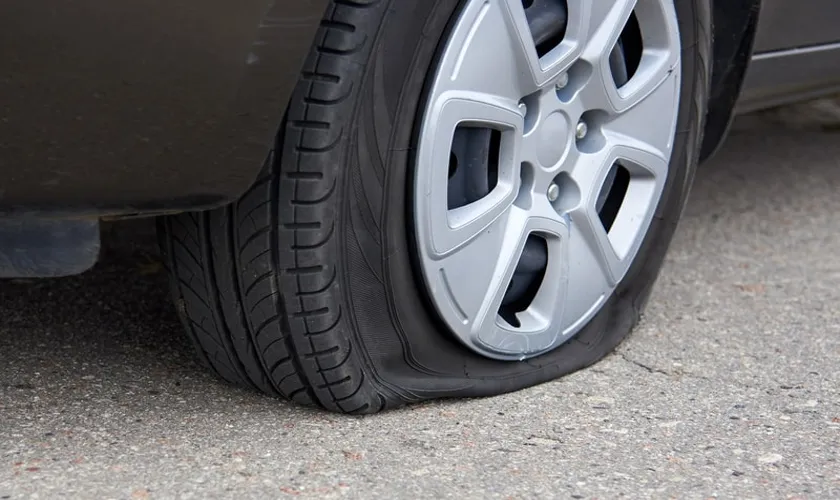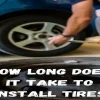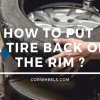Have you ever experienced a wobbly or bumpy ride while driving? It’s possible that you might have a flat tire. Knowing whether you have a flat tire or not can save you from further damage to your vehicle and ensure your safety on the road. Flat tires can occur due to several reasons such as punctures, sharp objects on the road, or even due to worn-out treads.
In this blog post, we will explore various signs that indicate you have a flat tire and what measures you can take to avoid any mishap. So buckle up, and let’s dive in!
Tire Pressure
Knowing whether or not you have a flat tire can be a bit of a challenge, especially if you’re not an expert in cars. One easy way to tell is to check your tire pressure. Your vehicle’s optimal tire pressure is typically listed in the owner’s manual or on a sticker inside the driver’s side door.
Using a tire pressure gauge, you can check each tire’s pressure and compare it to the recommended level. If one or more tires are significantly lower than they should be, you may have a flat tire. Additionally, if you notice your car pulling to one side or hear a thumping or flapping noise while driving, these could also be signs of a flat tire.
It’s important to address a flat tire as soon as possible to avoid further damage to your vehicle or risking your safety while driving.
Check Your Tire Pressure Regularly
Tire pressure can affect your vehicle’s fuel efficiency, handling, and overall performance, which is why regularly checking your tire pressure is essential. In fact, underinflated tires can cause you to lose up to 15% of your gas mileage and can also cause your tires to wear down more quickly. On the other hand, overinflated tires can make your vehicle hard to control, especially on wet or slippery roads.
That’s why it’s important to check your tire pressure at least once a month and before long trips. You can find the recommended tire pressure for your vehicle in the owner’s manual, on the tire itself, or by consulting a professional. Plus, maintaining the proper tire pressure can even save you money in the long run by extending the life of your tires and preventing costly repairs.
So, don’t underestimate the importance of tire pressure – it’s a small but significant aspect of vehicle maintenance that can make a big difference.

Low Tire Pressure Warning Light
If you’re driving and suddenly see a low tire pressure warning light on your dashboard, it can be concerning. This warning light indicates that one or more of your tires has low pressure, which can affect your vehicle’s performance and safety. It’s essential to address this warning as soon as possible by checking the tire pressure and filling it to the recommended level.
Driving on underinflated tires can cause unnecessary wear and tear, leading to decreased fuel efficiency and even tire failure. So, keep an eye out for the low tire pressure warning light and make sure your tires are properly inflated to ensure a safe and comfortable driving experience.
Visual Inspection of Your Tires
Tire Pressure Checking tire pressure is important to ensure that your tires are functioning properly. It’s easy to do and can be done at home with the right equipment. Start by finding out the recommended tire pressure for your vehicle, which can be found in your car’s manual or on the sidewall of your tire.
Then, use a tire pressure gauge to check the pressure of each tire. If the pressure is below the recommended level, use an air compressor to inflate it to the correct level. It’s important not to overinflate your tires, as this can cause them to wear out faster.
Checking tire pressure should be done regularly, at least once a month, to ensure optimal performance and safety. Don’t neglect tire pressure, as it can affect your vehicle’s handling and fuel efficiency. Keep your tires properly inflated to ensure a smooth ride and get the most out of them in terms of longevity and performance.
Driving Sensations
If you’re on the road and suddenly feel like your vehicle is pulling to one side or hear a loud thumping noise, there’s a good chance you have a flat tire. Another indication is a vibration on the steering wheel or gas pedals. A flat tire can be a scary experience, but staying calm and knowing what to do can make all the difference.
The first thing you should do is try to steer your vehicle to a safe place away from traffic. Once you have stopped, inspect your tire to see if it’s punctured, shredded, or deflated. If the tire is flat, your best bet is to replace it with the spare tire in your trunk if you have one.
Make sure to keep your vehicle manual in the car in case you don’t know how to change a tire. If you don’t have a spare or feel unprepared for the job, call for roadside assistance. Being aware of the signs of a flat tire and knowing what to do can help you stay safe on the road.
Vibrations While Driving
As you’re driving, you may have noticed certain vibrations or sensations that can make the ride less enjoyable. These vibrations can come from a variety of sources such as uneven roads or worn-out tires. Not only can they be annoying, but they can also cause damage to your car’s parts if left unchecked.
If you’re experiencing vibrations while driving, it’s important to figure out the root cause so you can address it properly. Ignoring it can lead to more serious problems down the road. So next time you feel those jarring sensations, don’t just brush it off – take the time to investigate and get your car running smoothly again.
Difficulty Steering
Difficulty steering can be a frightening experience while driving. There are many different driving sensations that can be caused by a problem with your steering. One of the most common sensations is a wandering feeling, where your vehicle feels like it’s drifting from one side of the road to the other.
This can be caused by loose or worn suspension components, tire issues, or a problem with your alignment. Another sensation is a pulling to one side, which is often caused by uneven tire pressures or a misaligned front end. You may also feel a shaking or vibration in your steering wheel, which could indicate a problem with your tire balance or suspension.
No matter what the issue is, it’s essential to have your steering system checked by a qualified mechanic to ensure your safety on the road. So, if you’re ever experiencing difficulty steering, don’t hesitate to have it looked at as soon as possible to avoid any potential accidents or injuries.
Tire Noise
Tire noise is a common issue that can make driving uncomfortable and frustrating. It can be caused by various factors ranging from tread design to road surface conditions. The noise can be described as a rumble or hum and can vary in intensity depending on the speed of the vehicle.
Although it may not seem like a big deal, tire noise can have a significant impact on driving sensations. For example, it can cause fatigue and stress, making long drives unbearable. Additionally, it can drown out audio from the car’s entertainment system, leading to further frustration.
The best solution for tire noise is to ensure proper tire maintenance, such as maintaining the correct tire pressure and ensuring the tires are aligned and balanced. By doing so, drivers can reduce the noise levels significantly and enjoy a smoother, more comfortable ride.
Physical Signs
If you’re wondering how to know you have a flat tire, one of the most apparent physical signs is that your vehicle will start to pull in one direction while you’re driving. This happens because the flat tire can no longer support the weight of the vehicle equally, which results in an uneven distribution of weight. Additionally, you may start to hear a thumping or flapping sound coming from your tire, which means that the tire has lost air pressure and is hitting the ground with every rotation.
You might also notice that the tire looks visibly flat or deflated, which is a clear indication that it needs to be replaced or repaired. If you suspect that you have a flat tire, it’s essential to pull over as soon as it’s safe to do so and check the tire’s pressure with a gauge. Don’t ignore the signs of a flat tire, as driving on one can lead to more severe damage to your vehicle or even accidents on the road.
Bulges or Blisters on the Tire
If you notice any bulges or blisters on your tire, it could be a sign of a serious problem. These physical signs are caused by damage to the internal structure of the tire, such as a broken belt or ply separation. Bulges or blisters can be a safety hazard because they can cause the tire to fail unexpectedly, especially at high speeds.
It’s important to get your tire checked by a professional as soon as possible if you see any bulges or blisters. Remember, prevention is always the best strategy when it comes to tire safety. Regularly inspect your tires for signs of damage and replace them when necessary to ensure your safety on the road.
Don’t take any chances with your tires – if you see something that doesn’t look right, get it checked out right away. Your safety could depend on it.
Cuts or Gouges on the Tire
If you notice cuts or gouges on your tire, it’s important to address the issue right away. These physical signs can indicate that your tire is nearing the end of its lifespan or has been damaged by debris on the road. Ignoring these warning signs can lead to a blowout while driving, which can be incredibly hazardous.
It’s always better to be safe than sorry when it comes to your tires. If you see any cuts or gouges, take your vehicle to a reputable tire shop to have the tire inspected and potentially replaced. Think of it as investing in your safety on the road – you can’t put a price on that.
Conclusion
If your steering feels wonky, and you hear a thumping noise, Or if your car suddenly starts to shake, without any rejoice, Stop your ride, halt your drive, and take a look down below, For a flat tire will bring you strife, and a risk wherever you go. Check the pressure, examine the treads, and see if it’s deflated and limp, For knowing how to spot a flat tire is crucial, and it’ll save you time and a headache’s whim. So keep an eye out, and don’t let it slide, A flat tire is easy to diagnose, and it’s best to fix it with pride!”
FAQs
What are the signs of a flat tire?
Some signs of a flat tire include a sudden drop in tire pressure, the car pulling to one side while driving, and a loud thumping noise while driving.
How can I check if I have a flat tire?
You can check for a flat tire by examining the tire’s appearance, checking the tire pressure with a gauge, and driving slowly and carefully to see if the car is pulling to one side.
What should I do if I suspect I have a flat tire?
If you suspect that you have a flat tire, pull over to a safe location and inspect the tire. If a flat is confirmed, change the tire if possible, or call for roadside assistance.
Can a flat tire be repaired?
Depending on the severity of the damage, a flat tire can often be repaired. However, if the damage is too severe or if the tire has been driven on while flat, it may need to be replaced entirely.
How do I prevent getting a flat tire?
You can prevent getting a flat tire by regularly checking tire pressure, inspecting tires for signs of wear or damage, avoiding potholes and debris on the road, and practicing safe driving habits.
How often should I check my tire pressure?
It is recommended to check your tire pressure at least once a month.
What should I do if I get a flat tire while driving?
If you get a flat tire while driving, slowly and carefully pull over to a safe location, turn on hazard lights, and follow the steps to change the tire or call for roadside assistance.



